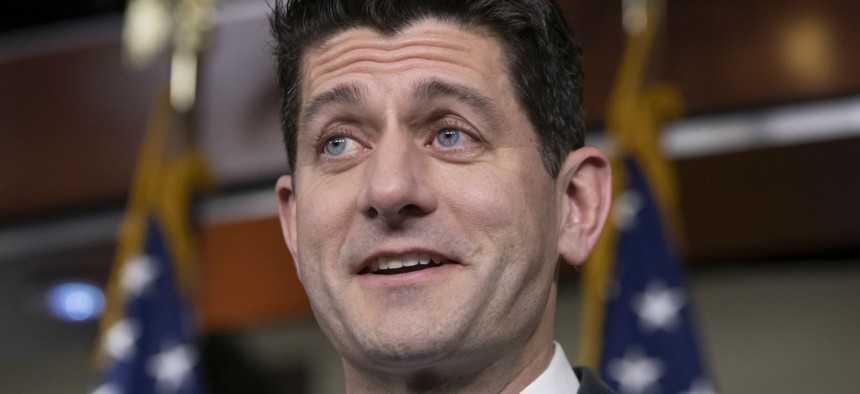Paul Ryan Will Leave Behind a Legacy of Hostility Towards Feds
The speaker's retirement could come as a relief to federal workers who feared Ryan would cut their compensation.
The most powerful member of the House announced on Wednesday he would retire from Congress at the end of his current term, likely leaving behind a legacy of attempted but seldom realized cuts to federal employees’ pay, benefits and jobs.
House Speaker Paul Ryan, R-Wis., said he would step down at the end of the year after serving as the chamber’s top lawmaker since late 2015. Federal employees may best remember Ryan for a previous title, when he was chairman of the House Budget Committee. Ryan rose to prominence in part when he put forward budget plans in several consecutive Congresses that aimed to eliminate annual deficits within 10 years. To accomplish that goal, Ryan proposed draconian cuts to federal agencies’ spending levels.
Some of those proposed cuts went directly after the federal workforce: Ryan’s blueprints would have slashed the number of federal employees by 10 percent through attrition. Agencies would have been required to replace just one worker for every three who left federal service. He also pitched higher pension contribution levels, suggesting feds contribute 6.35 percent of their paychecks toward their defined benefit.
Ryan proposed continuing a federal pay freeze for three additional years, after it had already been in place for two. The plan would have eliminated the Federal Employees Retirement System annuity supplement, which benefits those government workers who retire before the age of 62 and who are not eligible for Social Security, something presidents Obama and Trump both endorsed. It also would have eliminated student loan repayment benefits for federal workers.
In 2013, Ryan negotiated with Sen. Patty Murray, D-Wash., a two-year budget deal that raised sequester caps, and as one of the offsets, increased feds’ pension contribution level to 4.4 percent. That plan only affected workers hired after 2013, however, grandfathering in existing employees.
Ryan has praised federal employees, saying his targeting of their pay and benefits was rooted in the need to cut federal spending.
“The federal workforce is composed of some of the best educated and most dedicated people in America,” Ryan wrote in his 2014 budget blueprint. “This workforce is integral to a well-functioning government. However, taxpayers must also receive an excellent value for their dollars.”
He also touted what he views as a disparity between private and federal sector pay, saying federal employees earn, on average, 16 percent more than their private sector counterparts.
“Federal workers deserve to be compensated equitably for their important work,” Ryan wrote in his plan, “but their pay levels, pay increases and fringe benefits should be reformed to better align with those of their private-sector counterparts.”
Ryan did not aggressively pursue such changes in his leadership position as House speaker. He did allow the Holman Rule, making it easier for lawmakers to eliminate federal jobs and enabling them to reduce the salaries of individual federal employees, to resurface last year, but the House never used the authority. He has also presided over two brief government shutdowns this year.
The speaker has also maintained an interest in improving management at federal agencies. Last year he shepherded through the House the Foundations for Evidence-Based Policymaking Act (H.R. 4174), which would require agencies to more systematically assemble data for their decision makers before evaluating programs. The bill passed the House in November but has yet to receive a vote in the Senate.




